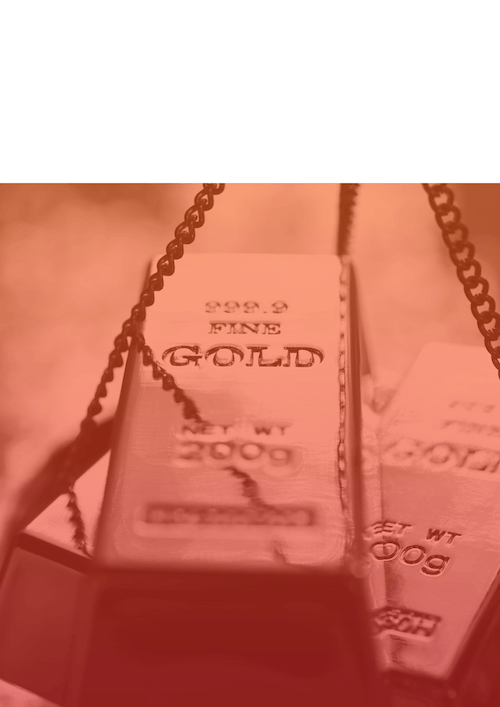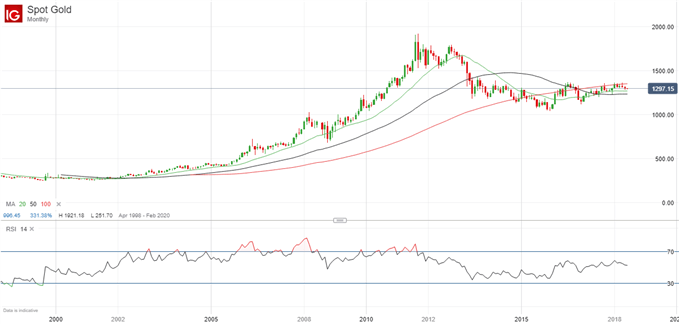Gold trading strategy:
- Trading gold is much like trading forex if you use a spread-betting platform
- A gold trading strategy can include a mix of fundamental, sentimental, or technical analysis
- Advanced gold traders recognize that the yellow metal is priced in US Dollars and will account for its trend in their gold analysis



Why trade gold and what are the main trading strategies?
Once upon a time, trading gold was difficult: you had to buy and sell the metal itself. Then came futures and options, allowing traders to take positions without actually ending up with a safe full of bars, coins or jewelry. Gold exchange-traded funds (ETFs) made it easier still; trading gold was much like trading a stock.
Today, trading gold is almost no different from trading foreign exchange.
If a retail investor uses a spread-betting platform it is simply a matter of buying or selling depending on whether you think that the gold price is likely to rise or fall.
For some people, trading gold is attractive simply because the underlying asset is physical rather than a number in a bank account. There are a variety of strategies for trading gold ranging from studying the fundamental factors affecting supply and demand, studying current positioning of gold traders, to technical analysis and studying the gold price chart.
Even for those who rely principally on the fundamentals, many experienced traders would agree that a better gold trading strategy is incorporating some components of fundamental, sentiment, and technical analysis. A gold trading tip we offer is that fundamental and sentiment analysis can help you spot trends, but a study of the gold price chart and patterns can help you enter and exit specific trades.
Trading gold vs trading forex
Gold has traditionally been seen as a store of value, precisely because it is not subject to the whims of governments and central banks as currencies are. Gold prices are not influenced directly by either fiscal policy or monetary policy and will always be worth something – unlike a currency that can end up being almost worthless because, for example, of rampant inflation.
Gold can also be used by traders as a “safe haven”, along with assets like the Japanese Yen, the Swiss Franc and the notes and bonds issued by the US Treasury. That means that when traders are worried about risk trends they will tend to buy haven assets. On the flip side, traders tend to generally sell haven assets when risk appetite grows, opting instead for stocks and other currencies with a higher interest rate. This makes gold an important hedge against inflation and a valuable asset.
Note, though, that while it is possible to trade the Swiss Franc or the Japanese Yen against a variety of other currencies, gold is almost always traded against the US Dollar. Therefore, trading gold means you will need to take into account the movements of the US Dollar. For example, if the value of the US Dollar is increasing, that could drive the price of gold lower. Keep up to date with the US Dollar and key levels for gold in our gold market data page.
An additional factor to take into account when learning how to trade gold includes market liquidity. The World Gold Council estimates that average daily trading volumes in gold are higher than in any currency pairs other than EURUSD, USDJPY and GBPUSD. That makes it higher, for example, than the daily trading volume in EURJPY, so spreads – the differences between buying and selling prices – are narrow making gold relatively inexpensive to trade.
Lastly, gold trading hours is nearly 24 hours per day. Gold exchanges are open almost all the time, with business moving seamlessly from London and Zurich to New York to Sydney and then to Hong Kong, Shanghai and Tokyo before Europe takes up the baton again. This means liquidity is high around the clock although, as with foreign exchange, it can be relatively quiet after the New York close, with lower volumes and therefore the possibility of volatile price movements.
How to trade gold using technical analysis
Technical traders will notice how the market condition of the gold price chart has changed over the years. Gold prices were in a sizeable trend from 2005 to 2015. Since 2015, gold prices have been trading in a defined range, changing hands between $1,000 and $1,400. In our DailyFX courses, we talk about matching your technical gold trading strategy to the market condition. If the market is trending, use a momentum strategy. If the gold chart is range bound, then use a low volatility or range strategy. This is a key ingredient in a gold trading strategy.
Gold Price Chart, Monthly Timeframe (June 2004 – June 2018)

For those who prefer to use technical analysis, the simplest way to start is by using previous highs and lows, trendlines and chart patterns. When the gold price is rising, a significant previous high above the current level will be an obvious target, as will an important previous low when the price is falling.
Also in an uptrend, a line on the chart connecting previous highs will act as resistance when above the current level, while a line connecting previous higher lows will act as support – with the reverse true in a falling market. As for chart patterns, those like head-and-shoulders tops and double bottoms are relevant just as they are when trading currency pairs.
For the more sophisticated technical trader, using Elliott Wave analysis, Fibonacci retracement levels, momentum indicators and other techniques can all help determine likely future moves
How to trade a symmetrical triangle pattern on the gold chart
Gold trading tips for beginners and advanced gold traders
Returning to fundamental analysis, the beginner needs to consider one point in particular: is market sentiment likely to be positive or negative? If the former, then the gold price is likely to fall and if the latter it is likely to rise. This is therefore the simplest strategy to use when trading gold.
For the more advanced trader, though, it is important to consider too what is likely to happen to the Dollar. In recent years, the Dollar has become increasingly regarded as a safe haven as well, which explains in part why the gold price in Dollars has remained relatively stable. Thus if you think, for example, that the geopolitical situation is going to worsen, you might consider buying gold but at the same time selling, say, the Australian Dollar against its US counterpart.
An advanced trader will also want to keep an eye on the demand for gold jewelry. In India and China in particular, gold jewelry is still seen as an important long-term investment, it has its uses in industry too and central banks’ buying and selling of gold can also be important – all factors that can move the price.
As for supply, advanced traders will want to keep an eye on the output figures from the main producing companies such as Barrick Gold and Newmont Mining.
That said, all the rules of trading forex also apply to trading gold. Retail traders need to be careful not to over-leverage and to think about their risk management, setting targets, and stops in case something goes wrong.
Our principal gold trading tips are therefore:
- Consider whether the markets are in “risk on” or “risk off” mode;
- Look at the likely performance of the US Dollar as well as the gold price;
- Consider a mix of fundamental, sentimental, and technical analysis;
- Watch out for central bank buying or selling;
- Consider the demand for gold jewelry;
- Look at the industrial demand for gold;
- And take account of the supply position.



You might also be interested in...
- Trading the Gold-Silver Ratio: Strategies and Tips
- What is Gold? Understanding Gold as a Trader's Commodity
Resources to help you trade the markets
Whether you are a new or an experienced trader, at DailyFX we have many resources to help you: analytical and educational webinars hosted several times per day, trading guides to help you improve your trading performance. You can learn how to trade like an expert by reading our guide to the Traits of Successful Traders.






